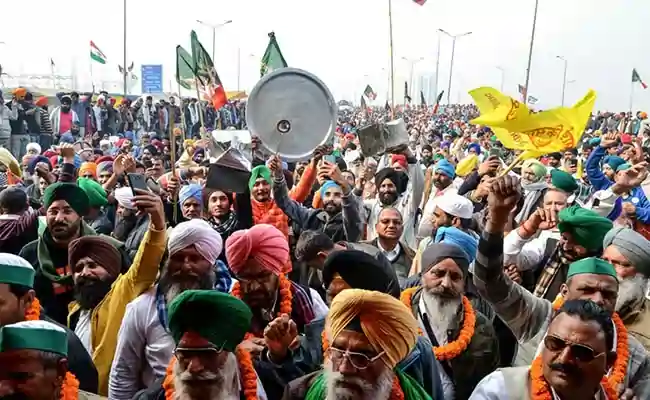What is MSP: The farmers’ protests are now on their 8th day after days of demonstrations. The protesting farmers are demanding a guarantee of MSP. Here’s an explanation of why they want a guarantee and what critics say about it.
Most farmers operate in a market where buyers dominate. As their crops, barring milk, are harvested in large quantities and sold, the supply of these products can suddenly increase relative to demand. This puts downward pressure on price.
Farmers are also price takers and not price makers in such market conditions that favour buyers over sellers. Lacking the market power to influence the prices of their produce — or to even set the MRP (maximum retail price), as firms in most industries do — they sell at prevailing supply-and-demand-determined rates.

Even worse, even though their crops are sold at wholesale prices, they still pay retail prices for everything, from diesel, seeds, pesticides, and tractors to toothpaste, soap, cement, and medicines.
Farmers do not always demand minimum support prices for their crops. In the run-up to the Lok Sabha election, parties may be under pressure to include a “legal guarantee of MSP” in their party manifestos.
Price vs Income Supports
The majority of economists are against government-set MSPs that are based solely on cost-plus pricing without any consideration for market demand. They say that farmers should plant according to what the market wants, as indicated by the prices of various crops at any given time.
Cost-plus MSPs, which ignore demand conditions, will cause farmers to make production decisions that are not based on the market. This could lead to an oversupply or undersupply.
Most economists believe it’s better to support farmers with “income” instead of “price.” This would involve a transfer of a certain amount into their bank account each year, either per farmer (as with the Centre’s pm-Kisan Nidhi scheme) or per acre (as with Telangana’s Rythu Bandhu).
Direct income support programs are not market-distorting, as they benefit all farmers regardless of the crop or quantity that is grown or who sells it.
The flip side of everyone getting paid the same amount is that it leaves the real producer farmer who invests more time, resources, and effort in the field.
Farmers who are sowing and harvesting crops now but have a few more months to go might be entitled to some price guarantee.
MSP guarantees are not unreasonable, especially for those who face more price and production risks (due to weather, pests, and diseases).
Price support is also a good tool to encourage crop diversification. If they know that their MSP will cover the Cost of pulses, millet, and other less water-intensive, nutrient-dense crops, farmers are more inclined to plant them than rice, sugarcane, wheat, or any other crop.
As long as MSPs don’t deviate too much from market rates or inter-crop price parity, the next question deserves an answer.
What Are The Main Demands Of Farmers Or What is MSP?
The farmers’ market is booming. The 12-point agenda for a minimum support price (MSP) law All crops and crop prices are determined in accordance with the Report of Dr. M S Swaminathan.
According to the Swaminathan Commission report, the government must raise the MSP by at least 50% over the weighted average Cost of production. It is also called the C2+50% formula.
This includes the Cost of capital-impaired rent on land (called “C2”) to give farmers a 50% return-imputed cost, which is a method of accounting for the opportunity costs associated with using resources such as land, labour, and capital.
- The Cost of capital is the interest or return that would have been possible if the capital invested in agriculture had instead been invested somewhere else.
- Other demands include farmers and workers being eligible for a full waiver of debt.
- Implementation of the Land Acquisition Act of 2013 With provisions for written consent of farmers before acquisition and compensation At four times the collector’s rate. A collection rate is a minimum value for registering a property when it’s bought or sold. These rates are used as a guideline in order to prevent undervaluation and tax evasion.
- The perpetrators of the October 2021 Lakhimpur Kheri murders will be punished;
- India should withdraw from the World Trade Organization and freeze all Free Trade Agreements (FTAs).
- Pensions for farm workers and farmers
- Compensation will be provided to the families of farmers who were killed during the Delhi 2020 protest which includes a job.
- The Electricity Amendment Bill 2020 must be scrapped.
- The scheme should include a daily wage of Rs 700 and 200 days (instead of 100) of employment per year under MGNREGA;
- Improvements in the quality of seeds; strict penalties and fines for companies that produce fake pesticides, fertilisers, or seeds;
- National Commission for Spices such as Chilli and Turmeric
- Assert the rights of indigenous peoples to water, forests, and land.
What Is The Government’s Response?
- After repealing three farm laws in November 2021, the Indian Government announced the formation of a committee to discuss MSP. The committee’s goal was to discuss MSP and zero-budget natural farming, as well as decide on crop patterns. This committee was created in July 2022 but has not yet produced a report.
- In a recent meeting with the leaders of farmer unions, the government proposed to form a new group consisting of representatives from the agriculture, rural, and animal husbandry ministries.
- This committee would respond to the farmers’ request for MSP on all crops. The government has promised that the new committee will meet regularly and complete its work within a specified timeframe.
What Are The Challenges With The Legalisation Of MSP?
- Forced procurement: The government could be forced to purchase all products at MSRP, leading to overproduction and wasting resources.
- It could also alter crop patterns, as farmers may prioritise crops that have a higher MSP than others. This would affect soil health and biodiversity.
- Discrimination among Farmers: A law of this kind could lead to disparities in the amount of money farmers receive for growing certain crops compared to those who grow other crops.
- The government may not provide support to farmers who grow unsupported crops.
- Pressure from TradersPrivate traders are resistant to any legal guarantee of MSP because prices are at their lowest during peak harvest periods.
- Financial Burden: Due to the obligation to purchase all crops at the MSP, there could be fiscal strains for the government.
- Social Implications Excessive procurement and distorted cropping patterns could have wider societal implications. They may affect food security, sustainability of the environment, and economic stability.
What Is The Current State Of MSP and Farmer Demand?
- Current MSP vs. farmer demands: The government has set the MSP at Rs 2,275 for each quintal of wheat for the Rabi marketing season 2024-25, which is higher than the price demanded by farmers. C2 plus 50% is the Cost.
- The MSP, however, is calculated using the formula A2+FL. This includes only the costs paid out by the farmers. This results in a lower rate of MSP than C2 plus 50%.
- CACP Recommendations & MethodologyYou can also find out more about the following: Commission for Agricultural Costs & Prices MSP is recommended based on the A2+FL formula; what are the considerations? Only the paid-out costs, as well as the imputed value for family labour. This formula is different from the C2 formula, which includes extra factors such as the rental value of own land and interest on fixed assets.
- Return on Investment: The Cost of production in Punjab is Rs 1,503 for each quintal. Minimum Support Price is Rs 2,275.
- This means that farmers get Rs 772 more per quintal than their Cost of production. That’s a return of 51.36 % over C2.
- Punjab farmers also received a return of 49% on paddy compared to C2 and 152% compared to A2+FL.
How can MSPs Be Guaranteed?
Two conventional methods are available.
First, buyers are forced to pay MSP. Sugar mills must pay cane farmers a “fair, remunerative” or “state-advised” price within 14 days after purchase.
This approach, however, is fraught with implementation problems (recurring cane payment arrears as proof) or, worse still, the private sector choosing not to buy at all.
Second, government agencies can buy all the marketable products of farmers at MSP. This is not sustainable, physically or financially.
There is a third alternative: Price Deficit Payments (PDP). The government does not buy or stock any crops but pays farmers the difference between MSP and the market price if it is lower. This payment would be based on the amount of crop that is sold to private traders.
PDP was first tried in Madhya Pradesh via a Bhavantar Bhugtan Yojana.
This scheme determined the market price of a crop by the average model rate (most quoted) in the Agricultural Produce Market Committee mandis (APMC), Madhya Pradesh, and two other states that were growing during the month of sale.
The difference in price between the MSP and the quantity sold by the farmers was paid on the basis of an “anubandh para” (“sale agreement”), “to chi” (“weighment slip”), and “Bhutan pakora” (“payment letter” signed by both parties).
Madhya Pradesh implemented the scheme during the 2017-2018 kharif season (post-monsoon). It covered eight crops, including urad (black gram), soybean (pigeon pea), arhar (green gram), sesame (niger seed), and groundnut.
The scheme was not continued despite the fact that 21 lakh farmers registered and Rs 1,952 crore were paid.
What Is The Future of MSP?
Madhya Pradesh and Haryana have shown that it is possible to deliver MSP to farmers, at least for some crops other than rice and wheat.
The APMC mandi system and infrastructure for farmer registration that already exists in these states is one reason why they were able to achieve this.
It is possible to track each transaction – how much of a crop has been sold by a farmer at a particular price – and pay the difference based on this.
It may be possible to encourage other states to emulate the success of Madhya Pradesh or Haryana if a national PDP program with Central funding is implemented.
For a start, they could build the infrastructure and systems for markets that would allow even their farmers to receive MSP.
SEE MORE: India’s 1st Bullet Train Is Ready To Run on Track, Railway Minister Shares a Video, Watch Here!











2 thoughts on “What is MSP, How This Effect on Farmers and General Public, Know Here All Details”